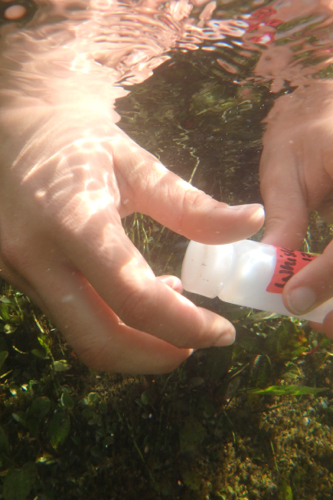Ellie and I made our last day in Alaska count. We met Janet, the wonderful PolarTREC PI, for quick coffee break - a nice change from all of our video conferences! Afterward, we spent the rest of the day on a fieldwork road trip south of Anchorage to the Kenai Peninsula to collect samples for Ellie's research.
Ellie, Darrell, and some labmates completed work in the Kenai lowlands in June. The area is unique. During the Pleistocene, two huge glaciers flowed together, leaving an ice sheet over what is now called the Kenai lowlands. The melting ice left behing hundreds of lakes, and if you have read my other journals, you now know that lakes mean sediments!
 Peterson Lake, one of the hundreds of scenic lakes in the Kenai.
Peterson Lake, one of the hundreds of scenic lakes in the Kenai.
Ellie is using isotopes to attempt to understand how climate has varied over hundreds of years. Isotopes are different weights of the same type of atom due to different numbers of neutrons. Oxygen has three naturally occurring isotopes: common O16, O17, which is so rare it is barely measurable, and rare but measurable O18. The ratio of oxygen isotopes in water gives clues about where water came from. Heavy O18 doesn't evaporate easily, so is more abundant in standing water that evaporates a lot. Light O16 evaporates easily, so is abundant in clouds. Many other factors influence isotope ratio, and Ellie is hoping to use them to understand how precipitation and storm origin in Southern Alaska has changed.
 Water samples used for isotopes must be collected underwater so there are no bubbles in the bottle.
Water samples used for isotopes must be collected underwater so there are no bubbles in the bottle.
To reconstruct paleoclimate using isotopes, Ellie will use soil cores, collected in June. Tiny bits of plant matter will be used to radiocarbon date different depths of the core. From these dated depths, Ellie extracts preserved algae, dissolves their outer shell, and measures oxygen isotopes, preserved in the inner shell of the algae.
What does this all have to do with our day on the Kenai? Just like with the Arctic Glacial Lakes project, to understand the past, we must attempt to understand the present. Ellie needed water samples from all of her lakes so that she could measure whether the isotopes changed from her samples collected earlier this summer.
 Ellie displays a water sample from on of the hundreds of lakes on the Kenai peninsula.
Ellie displays a water sample from on of the hundreds of lakes on the Kenai peninsula.
What that meant for us was a long scenic road trip. Driving past cliffs, mountains, bays, and forests, stopping just long enough to dip a bottle in each lake. It's almost impossible to imagine how many lakes are in the Kenai. Each one has its own personality, each one is beautiful. We saw waterfalls, bald eagles, swans, a really cool dragonfly, and many amazing vistas. The forest was so different from my experience from Alaska, and I was reminded again of just how vast the state is.
 A dragonfly perches near one of the many lakes of the Kenai.
A dragonfly perches near one of the many lakes of the Kenai.
 Ellie and Rebecca hike to a small lake to take water samples.
Ellie and Rebecca hike to a small lake to take water samples.
Our day ended over dinner while watching the sun set over Anchorage with another collaborator on the Arctic Glacial Lakes project, Johnse Ostman, a graduate student at Alaska Pacific University. The conversation and food were wonderful, and the views amazing. A fitting end to an amazing experience.


Add new comment